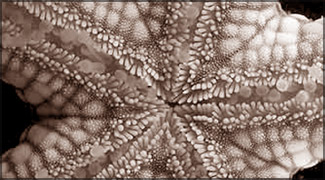Reef survey finds 500 new marine species
by Lewis SMITH
Hundreds of previously undocumented species have been found living in
and around one of the world's most visited coral reefs.
Bizarre and beautiful crustaceans, corals and colourful worms were
discovered off the Australian coast by researchers working for the
Census of Marine Life.
Many of the creatures had been seen repeatedly by scientists based in
nearby research stations and by divers and professional guides on the
Great Barrier Reef but no one had realised their significance.
|

Nardoa rosea sea star |
The species were identified during expeditions to the Ningaloo Reef
off the northwest coast, and Lizard and Heron islands off the northeast
coast, at opposite ends of the reef system.
Researchers said that the locations and quantity of previously
unrecog-nised species picked up in the survey demonstrated just how
little is known of the marine environment.
The survey concentrated on identifying little-known types of animals
including isopods, soft corals and worms. Creatures such as fish, hard
corals, sharks and sea slugs were ignored because their presence was
well documented already. "The impressive thing was the sheer number of
the species sitting under our noses.
These are places people have been diving on for years and they have
research stations," said Julian Caley, of the Australian Institute of
Marine Science.
He estimated that among more than 1,000 species found during the
three expeditions, 300 to 500 were unknown to science, and he expects
more over the next two years as the reefs are revisited. Detailed
analysis has to be carried out yet but the newly catalogued species are
thought to include 150 soft corals, 130 crustaceans and up to 100 worms.
Urchins, basket stars, which are closely related to starfish, and
seaweeds were also among the finds.
"In spite of all our activities we still don't know what's under our
noses," he said. "What we've found during these three expeditions
illustrates the size of the problem."
"It shows we don't have to go to the middle of the Pacific or Indian
oceans to find new species. They are just off our doorstep." Data
gathered by the survey team will help scientists to build up a picture
of the changes in diversity in different parts of the seas.
Previous work has revealed wide differences in the make-up of reef
eco-systems, with diversity within species generally decreasing the
further they are from the equator. The Census of Marine Life project
aims to provide comprehensive basic information on the make-up of life
in the seas, allowing researchers to be able to understand better the
effects of any changes in the marine environment.
"Corals face threats ranging from ocean acidification, pollution and
warming to overfishing and starfish outbreaks," said Ian Poiner, of the
Australian Institute of Marine Science. A proliferation of starfish can
be damaging as some species, particularly the Crown of Thorns, eat
coral.
Dr. Poiner added: "Only by establishing a baseline of bio-diversity
and following through with later censuses can people know the impact of
those threats and find clues to mitigate them."
The new isopods, small creatures usually just a matter of millimetres
long, were of particular interest to the research team because they are
regarded as a valuable indicator of diversity.
Scientists taking part in the project hoped that some of the newly
discovered isopods would be found to lead as bizarre lives as those that
eat off the tongues of live fish and are already known to be present off
the Australian coast.
Ron O'Dor, chief scientist at the census, added: "Amazingly colourful
corals and fishes on reefs have long dazzled divers, but our eyes are
just opening to the astonishing richness of other life forms in these
habitats. "We must wonder why nature has evolved such prolific diversity
on coral reefs. While they are icons of diversity, the processes that
have generated and maintained coral reef bio-diversity are still
unknown." |
